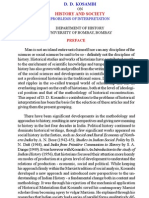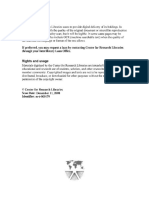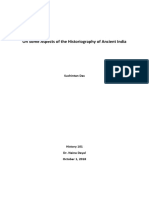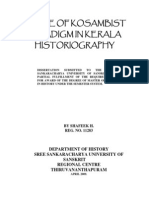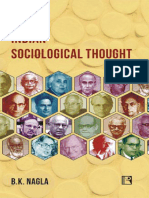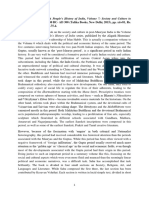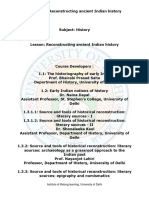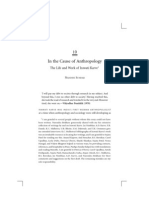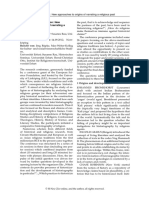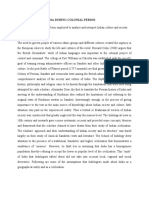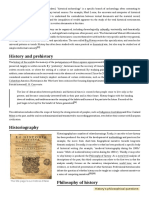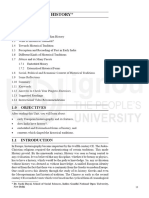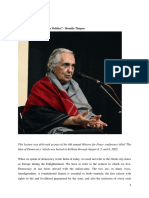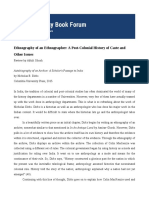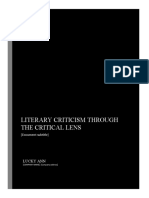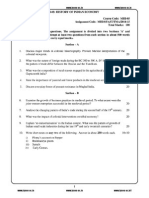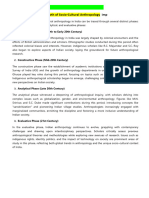Early Indian History and The Legacy of DD Kosambi: Romila Thapar
Early Indian History and The Legacy of DD Kosambi: Romila Thapar
Uploaded by
Abhishek HandaCopyright:
Available Formats
Early Indian History and The Legacy of DD Kosambi: Romila Thapar
Early Indian History and The Legacy of DD Kosambi: Romila Thapar
Uploaded by
Abhishek HandaOriginal Title
Copyright
Available Formats
Share this document
Did you find this document useful?
Is this content inappropriate?
Copyright:
Available Formats
Early Indian History and The Legacy of DD Kosambi: Romila Thapar
Early Indian History and The Legacy of DD Kosambi: Romila Thapar
Uploaded by
Abhishek HandaCopyright:
Available Formats
GENERAL ARTICLE
Early Indian History and the Legacy of DD Kosambi1
Romila Thapar It is an immense honour for me to have been asked to give this lecture inaugurating the year long remembrance of DD Kosambi during his birth centenary. Celebrating his work as a historian, apart from his contribution to mathematics and science, calls indeed for considerable celebration. For me personally it is remembering someone whose work provoked me into thinking beyond the obvious in my interpretation of early Indian history and who allowed me the privilege of some valuable discussion. I mean this quite literally as he was not easily accessible and discussion with him was therefore a privilege. I first met Kosambi fifty years ago. In 1956, I was a PhD student at the School of Oriental and African Studies of London University, working on a thesis on Ashoka Maurya. My supervisor Professor Basham announced one day that he had invited Kosambi to give some lectures on Hinduism. We had read a couple of his papers, but his book, An Introduction to the Study of Indian History, was to be published later that year. His first lecture we assumed would be about the Rigveda, since scholars generally began with that. But no. He showed some slides of a domestic ritual associated with the name-giving ceremony of a child. It involved dressing the pestle of the household in baby clothes and placing it in the childs cradle. Kosambi provided an explanation that touched on many facets: the bestowing of blessings and imbuing the child with strength, belief systems in prehistoric societies, theories of mother-right, and fertility rituals. He argued that the beginnings of Hinduism lay in these ideas and practices. Religion was and is not just a matter of belief but also involves, and perhaps even more so, the meaning of the ritual occasion as social articulation. In the course of that year I was visiting Mauryan period sites in connection with my thesis. Coming to Bombay, I mentioned to
Romila Thapar is an Indian historian whose principal area of study is ancient India.
A slightly expanded version of
a lecture given at Pune on 31 July 2007 to mark the inauguration of the birth centenary year of D D Kosambi.
Keywords D D Kosambi, early Indian history, numismatics.
RESONANCE June 2011
551
GENERAL ARTICLE
my brother Romesh Thapar that I would like to discuss my work with Kosambi. My brother and others such as Sham Lal (Adib) were part of a small but lively study group that had been discussing with Kosambi his manuscript of what was to be published as An Introduction to the Study of Indian History. On my contacting Kosambi he explained that he was rather busy that week, but on hearing that I was going to Pune, suggested we travel together by the Deccan Queen on which he commuted between Pune and Bombay. It was a memorable journey. He had walked the entire route and knew every hill-top, stone and tree of consequence in terms of ethnographic and historical connections. His familiarity with the landscape was phenomenal. Those of us who were backing up our library research with field work had to think again about the meaning of field work and the co-relation of literary and tangible sources. I called on him in Bombay at the TIFR on a few other occasions and our conversations were largely clarifications that I was seeking on what he had written. Prior to the publication of the Introduction, his papers on history had been published in various journals such as the Bombay Branch of the Asiatic Society and The Annals of the Bhandarkar Research Institute. These were scattered papers and not always easily accessible. It was helpful therefore to have his ideas on history distilled into three books: An Introduction to the Study of Indian History (1956), Myth and Reality: Studies in the Formation of Indian Culture (1962) and The Culture and Civilisation of Ancient India in Historical Outline (1965). His important papers pertaining to history have been republished now in a collection2. Kosambis major writings date to the 1950s and 60s although he had begun to publish articles on Indology and Indian history earlier. These years were a turning point in the study of ancient history3 and his writing was in many ways a crossing of the threshold. His studies moved out of the confines of colonial and nationalist historical writing and made visible new dimensions of the past. What had earlier come under the rubric of Indology was now being inducted into the social sciences which were a
D D Kosambi, Combined Meth-
ods in Indology and Other Writings, Delhi, 2002, edited by B D Chattopadhyaya. Henceforth CMI.
3
R Thapar, Decolonising the
Past: Historical W riting in the Time of Sachin and Beyond, Economic and Political Weekly, 2 April 2005, XL,. 14, 1442 1448; R Thapar, Historiography, in Cultural Pasts, Delhi 2000, 1 173. The Contribution of D. D. Kosambi to Indology, 5273.
552
RESONANCE June 2011
GENERAL ARTICLE
different kind of study. This was largely because the earlier interest in dynastic history and chronology was being expanded to include social and economic history and the interface of this with cultural articulation. Culture for him was not a separate entity but an intrinsic part of the making of a historical context. This may sound trite today but fifty years ago the inter-weaving of society, economy and culture was a departure from the standard histories of ancient India4. His discussion of what he called combined methods in Indology was a reflection of this change5. These new dimensions gradually superceded the previous ones in terms of the primary interest of historians. In part this followed from the theoretical problems of social, economic and cultural change becoming the concerns of Indians in the post-colonial period. There was an interest now in ascertaining what had continued and what had changed from pre-colonial times. But it was also because the discipline of history was expanding its investigations into the past. Equal emphasis was now being given to understanding and explaining the past as was earlier given to gathering information on the past. Apart from the continuing discussion on colonial and nationalist historical writing on early India, there was a turning to other ways in which the Indian past had been viewed. Scholars of Indian history both in India and elsewhere were debating the ideas of Max Weber, the French Annales School and Karl Marx and their studies of some aspects of early India. Marxism elicited the maximum attention in India. The outstanding exponent of the Marxist interpretation of Indian history in all its complexity and the one, who ushered in a paradigm shift in the study of ancient Indian history, was D D Kosambi. The paradigm shift was the move away from colonial and nationalist frameworks and the centrality of dynastic history to a new framework integrating social and economic history and relating the cultural dimensions of the past to these investigations. This provided the context and highlighted the interface of different facets of society. In expanding historical information to include data from archaeology, linguistics, technology and ecology, he was also able to point out socio-economic hierarchies which he
The culmination of such stan-
dard histories were the volumes in the series called The History and Culture of the Indian People, published by the Bharatiya Bombay. Vidya Bhavan,
Combined
Methods
in
Indology, CMI, 329.
RESONANCE June 2011
553
GENERAL ARTICLE
recognized as social inequalities and explain how they impacted history. For him history was the presentation in chronological order of successive developments in the means and relations of production. Historical study therefore did not stop with chronological narrative but required the investigation of many interrelated facets. Production was not confined to just the economy and technology of the time but involved an understanding of the multiple aspects of a society that constituted its entirety. For the lecture this evening I have chosen only a few themes out of the many from his writing and which I think have been seminal to the study of early Indian history. Given the versatility of his historical interests it is difficult to make a selection but I have selected three. I shall be speaking on his discussion of the relationship between tribe and caste, on the link between Buddhism and trade and on the nature of feudalism in India. His discussions reflect not only his formidable grasp on Indian data but also demonstrate his readings in Greco-Roman and Medieval European studies, readings that validate the importance of comparative history. In referring to these three themes I would also like to mention the questions they raise and the ways in which these have come into discussion in subsequent studies.
6
The Culture and Civilization of
Ancient India, London, 1965, 172. Henceforth CCAI.
7 On the origin of Brahmin Gotras,
CMI, 98188.
The relationship of tribe to caste was for him a basic historical process in India6. His familiarity with this process drew on his readings of texts and his observations in the course of fieldwork. Additionally it was important to his understanding of class confrontations. His focus was on the two ends of the social spectrum: the organization of the brahmana varna and the creation of the shudra varna. The former was that of the highest ritual status and in later periods included the substantial number of recipients of grants of land7. It was heterogeneous in origin although eventually it took a seemingly homogenous form. The shudra varna, within which he included the dasas, provided the labour force and was essential to the definition of class. He compared this category as we shall see, not to Greco-Roman slavery but to the Greek helots. Tribes were distinct because they were not shudras and neither were they slaves nor helots. They were a category outside
554
RESONANCE June 2011
GENERAL ARTICLE
caste and a pre-class formation. Tribe and caste were contrasting conditions. On occasion he equated varna with class but recognized situations where the equation did not hold. The tribe was a community where land rights were derived from kinship relations and not from ownership. Rules controlled the choice of marriage relations partly because recruitment into the community was by birth. Partaking of food was generally within the community and contacts with outsiders were not encouraged8. We can see here the process towards the creation of jatis with some of the characteristics of the tribe continuing. Confrontation and negotiation were both used in converting tribes into castes. As a societal change this involved mutations in the economy, in technology often in relation to the ecology, and in belief systems, all of which were important to Kosambis historical explanations. He saw the fundamental historical change as resulting from the extension of plough agriculture and the establishing of agrarian villages in areas that had previously been tribal lands, supporting scattered societies of hunter-gatherers, shifting cultivators and pastoralists. This change brought about the transition from pre-class social formations to castes that suggested class. In the context of these changing relationships his analyses of rituals and of cultural practices and their historical context were particularly striking. Religious articulations were not just ideologies of the ruling class asserting hegemony. They were also ways in which status and control were negotiated and these could draw on more than economic causes. The relationship between tribe and caste society is sometimes reformulated today as that between a clan-based society and the state. The term tribe has come to be used casually if not loosely to cover many societies and has lost the precision it may once have had. It is used for a range of social forms from foodgatherers to sedentary cultivators. A tribe can even incorporate more than one caste, as for example, in the descriptions of the Abhiras in early texts9. Clan is more specific and is also suggestive of the evolution towards jati as caste although this does not
D D Kosambi, Introduction to Hence-
the Study of Indian History, Bombay, 1956, 24 ff. forth ISIH.
M R Singh, A Critical Study of
the Geographical Data of the Early Puranas, Calcutta, 1972, 128132.
RESONANCE June 2011
555
GENERAL ARTICLE
negate the importance of varna. In a jati, recruitment is by birth into the jati (as it was in a clan), rules of endogamy and exogamy govern marriage; where occupation enters the definition it tends to restrict identity; and belief and ritual can be bound by a jati or at least identified with a cluster of them. A significant change is that the relatively egalitarian status among clans is undermined by caste hierarchy. Some continuity from the clan to the jati is discernable although it is not the same from clan to varna. This was a distinction which, in the writing of early Indian history, was underlined by Kosambi, although he did not discuss jati extensively in the context of caste. Varna as a category has not always conformed to the norms of the dharma-shastras and more so in the middle social levels where the caste status of varieties of groups could be adjusted. If varna is equated with class the equation varied with the context. The many intermediate categories of jatis as described in the normative texts had ambiguous identities in a system where hierarchy and inequality was emphasized. Where varna claimed divine sanction, this gave it yet another gloss. The preference for the term state rather than caste as the form of change has to do with the coming of the state bringing about a large range of changes of which the conversion to caste society is one, albeit an important one. It is also an indirect critique of the notion that in early India there was an absence of the state because it was encompassed by caste. The political formation of a state generally implies a kingdom although some historians include clan polities as state systems. Kautilyas well-known saptanga theory of the seven limbs that constituted a state are listed as: a state requiring a king, a demarcated territory, ministerial administration, the storing of revenue in a treasury, a fortified capital, coercion which presumably could be physical or legal, and the presence of allies in the neighbouring kingdoms10. Historians therefore, look for processes that help in the establishing of states which subsume many changes, some being the ones discussed by Kosambi. The change from tribe to caste is a complex historical process. Kosambi was drawing attention to this complexity as
10
Arthashastra 6.1.1.
556
RESONANCE June 2011
GENERAL ARTICLE
well as to the fact that it was basic to much of historical change in India. In the juxtaposition of tribe and caste or of clan and state, the encroachment on the tribe by caste society frequently resulted in its incorporation into the state. Apart from other factors this process also raises a number of questions on the etymology of words and consequently the interpretation of texts. Literal translations may not convey the exact meaning and may require to be correlated with the background of the society to which they refer. For instance, how is the term raja to be defined in its initial usage: as the chief of a clan or as a king, since both were called raja. The Arthashastra uses the same term for both but the context makes it clear as to which is meant11. The difference in meaning would alter the reading of the text. Kosambi used the meanings almost interchangeably, yet he was aware of the distinction. He quotes a phrase from the Rigveda, that Agni eats the forests as a raja does the ibhyas, to which he could have added the later quotation from the Shatapatha Brahmana of the kshatriya eating the vish, the clansmen, as the deer eats grain12. The simile of eating does not convey the sense of awe associated with majestic royalty controlling subjects. Its association is more suggestive of activities of the raja in, for instance, conducting cattle-raids to acquire wealth as described in the Vedas. We are told that even the well-established KuruPanchalas went out in the dewy season to conduct cattle raids13. These were a staple means of acquiring wealth in small societies, dependent on agro-pastoralism where protection by a royal army is absent or not forthcoming. This activity continued into later periods in rural areas as is evident from the numerous hero-stones commemorating the hero defending the village cattle against raiders. In such situations there seems not to have been a reliance on royal authority and defence was organized locally. Some heroes acquired immense status through this act of heroism and it is thought that they may even have been deified, as in the suggested origin of Vitthala at Pandharpur in Maharashtra. Historians of early India who are investigating such cultural flows are in part pursuing Kosambis
11
In the Arthashastra 11.1.5.
rajan refers to the chief of a clan.
12
Rigveda, 1.65. 47; ShataBrahmana, 3.3.2.8;
patha
Aitareya Brahmana, 8.17.
13
Taittiriya Brahmana, 1.8.4.1.
RESONANCE June 2011
557
GENERAL ARTICLE
insistence on investigating living prehistory. In terms both of continuities and of social origins the relation between clan and caste also features in Kosambis discussion on the gotra system among brahmanas14. This was a subject of debate with Indologists such as John Brough15. Myths of origin pertaining to rishis such as, Agastya and Vasishtha, said to have been born from jars were analysed as referring to much more than what the narrative suggests. Writing on what is often referred to as the Aryan question, Kosambi accepted the then current theory that Aryan speakers invaded India after the decline of the Harappan cities. However, he argued that there was an interface between the various communities old and new. This conditioned the resulting cultural forms many of which are articulated in the Vedic corpus. The interaction is reflected in changes in the Indo-Aryan language and religious beliefs and rituals. It can also be seen in the emergence of new social groups. For example, Kosambi pointed to the merging of Aryan and nonAryan in linguistic usage and its reflection in particular caste identities. Brahmanas such as the much-mentioned Kakshivant among others, referred to in the Vedas are said to be the sons of dasis, i.e., of dasa women. This was a significant statement. Described as dasyah-putra brahmana, in some ways an oxymoron, it was nevertheless a known category, initially reviled but soon respected by other brahmanas16. Thus, Kavasha Ailusha was first dismissed as being the son of a dasi but when it was found that the Sarasvati followed him wherever he went, his eminence was conceded17. This was the triumph of such brahmanas. Despite being of ambiguous caste they could be inducted into the brahmana varna. Such inductions are parallel to the legitimizing new kshatriyas in post-Gupta times. Kosambi suggests that some from this category may have derived their vocation from what survived of the Harappan priesthood but this suggestion remains speculative. Kosambi was demonstrating the difference between the continuity of the formal structure of caste and the
14
CMI, 98. J Brough, The Early Brahma-
15
nic al Sy stem of G otra and Pravara, Cambridge 1953. For Kosambis response see, Development of the Gotra System, CMI, 170 ff, 178 ff.
16
ISIH, 97100.
17 Aitareya
Brahmana, 2.19;
Kaushitaki Brahmana, 12.1.3.
558
RESONANCE June 2011
GENERAL ARTICLE
malleability of the functioning of caste which could contradict the normative codes. This raises another question: can we understand the nature of the Aryannon-Aryan interaction, (if we choose to call it that), through observing changes in the meaning of certain terms, as for example, dasa? As described in the Rigveda, the earliest of the Vedas, the dasa was in effect the Other of the arya. Inevitably what constitutes Otherness or being alien, is a reflection of the Self, if in nothing else then at least in the characteristics that are chosen to represent the Other. Neither the arya nor the dasa societies were homogenous, unified and monolithic. Societies and communities never are. Some dasa chiefs were arch enemies of the aryas but a few seem to have been patrons of the brahmanas. The dasas are feared because they are wealthy and their strongholds cannot be easily overcome. Their Otherness, lay in distinctions based on language, ritual observances, custom and perhaps, as some have argued, even appearance18. Their numbers seem to be exaggeratedly large. Possibly the fear is also because they are associated with sorcery yatudhana. Relations with the dasas change after a few centuries when in the later Vedic compositions they are regarded with contempt unless proved otherwise, as in the case of the Kavasha Ailusha and other such brahmanas. The status of the dasa had gradually been lowered and they now provided labour although the ritual specialists among them may have got a foothold into brahmanical ritual. The process by which this change occurred needs to be investigated in greater detail. How did the dasas, previously feared now become a group of bondsmen? It would also point to a change in the meaning of dasa, shifting from the Other, to the subordinate one. The understanding of these kinds of changes, in terms of the interaction between the varying societies that existed in the northwestern sub-continent at that time, introduces new questions and is far more helpful in explaining that period of history than the obsession with who was indigenous and who was foreign. The debate on the latter pays little attention to ascertaining whether
18
R Thapar, The Rigveda: En-
capsulating Social Change, in K N Panikkar et. al. (Eds.), The Making of History, Delhi, 2000.
RESONANCE June 2011
559
GENERAL ARTICLE
the consciousness of being indigenous or foreign had any meaning for those societies. Recognized boundaries were non-existent. Therefore the differences between us and them were based on other features such as language, cultural patterns and belief systems, as also on negotiating hierarchies of status. Agriculture, Iron Technology Kosambi had suggested that plough agriculture, iron technology, the use of the horse for mobility and a dependence on cattle for food, were among the crucial factors that gave the Aryan speakers an edge over other societies19. This allowed them to become the dominant culture. Plough agriculture weakened clan solidarity and allowed caste to become the agency of control over land. But the archaeological evidence for plough agriculture from more recent excavations goes back to pre-Harappan times and therefore prior to the presence of Indo-Aryan speakers. If the arya dasa relationship was between pastoralists and agriculturalists as seems likely then a different set of indices would also have to be analyzed. The introduction of iron technology dated to the second and first millennium BC, in addition to the existing copper and bronze, is said to have facilitated the clearing of forests to extend the area under cultivation. Subsequently the surplus from agriculture led later to the establishing of urban centres. But iron technology in itself is not a sufficient factor of change. The archaeological presence of iron varies from region to region and in some places dates to the second millennium BC. At some Megalithic sites in the peninsula it is prior to or contemporary with the presence of Indo-Aryan speakers in north India. Indo-Aryan was not the language in the more southern of the sites. The wide distribution of Megalithic sites was discovered subsequent to Kosambi so he did not know of it. The important question is not just the introduction of iron technology but the manner in which it might have been appropriated and used by those wishing to establish their authority. The locations of sources and the treatment of the metal forging or smelting and the function of artifacts would be
19
ISIH, 106 ff.; Stages of Indian
History, CMI, 62 ff.
560
RESONANCE June 2011
GENERAL ARTICLE
helpful in understanding the nature of the change brought by this technology. Similarly the production of a surplus from agriculture in itself is not sufficient to bring about urbanisation. Surplus is a process and has to be directed towards change as is done by those who use it as a resource. The crucial questions in Kosambis argument were who controls the technology and who works it. These questions still remains relevant. Trade The interaction between tribe and caste is an essential factor of historical change. But this was not the only social mutation in history. Parallel to this was the expansion of exchange relations from barter to commerce to which Kosambi drew attention. Trade introduces the dissolution of tribal bonds and the earlier nature of exchange which changes could encourage the coming of a class society. He brought into his study not only the geographical expansion of commerce in the post-Mauryan period but also its links with Buddhist monasteries particularly in the Deccan and their patronage from a wide cross-section of people20. This became another perspective of the mutation of tribes into complex polities. Where monasteries were linked to trade they signaled not only the presence of commerce but also of craft production and degrees of urbanism, not to mention an extension of agriculture, to support the commerce. Barter is more often associated with clan-based societies and can be transformed into commerce with the coming of the state and with extensive trading links. An obvious index of commerce as different from barter is the presence of coins as a common unit of value. This could also point to an increase in commodity production. Numismatics Kosambis work on numismatics was closely related to his professional training as a mathematician. He used the logic of mathematics to formulate his questions and statistical methods to examine the data. This was new in the study of coins. Coins circulating in the subcontinent during the earlier period were
20
ISIH, 246 ff; Dhenukakata,
CMI, 450475; The Buddhist Caves of Western India, 476 481; The Basis of Ancient Indian History (II), 327 ff ; CCAI, 327 ff.
RESONANCE June 2011
561
GENERAL ARTICLE
what have come to be called, punch-marked coins. These were small roughly square or rectangular shaped coins, largely of silver and some of copper that had a cluster of symbols on one side and small marks on the reverse. The coins coincided with the evolution of early historical urban centres in the Ganges plain and the north-west. They were in circulation from a little before the second half of the first millennium BC to approximately the end of the millennium. The challenge that they posed was that unlike later coins, they were neither dated nor did most of them carry an indication of the issuing authority. Only a small number carried the legend, negama. Therefore, the basic questions were: what did the symbols represent, who made the small reverse marks, and was there a way of separating the older coins from the later? Observing that the coins, mainly of silver, were cut with accuracy and that some came from hoards such as one from Taxila, Kosambi decided to use one such hoard as his basic data 21. A hoard would provide more reliable statistical data than stray finds. There was the further advantage that the terminal date of the hoard was known from the presence in it of a few dateable post-Mauryan Indo-Greek coins. Of the punch-marked coins some would have been in circulation for a longer period than others with a greater wear and tear. Kosambi argued that there was an age-weight correlation and that by measuring the weight with exactitude he would be able to provide a chronological flow from earlier to later coins. This he did meticulously. He then went on to study the distribution of the symbols and to interpret what they represented. The commonly used crescent on arches was read by him as a Mauryan symbol suggesting the name Chandragupta. His readings for dynasties and kings are debatable despite the logic of his reasoning, but the idea of using a statistical method in the study of coins is worth pursuing where possible. The other feature was that of the reverse marks. It had been thought that the coins were issued not by kings but by traders. The coins inscribed with the legend, negama, perhaps referred to an exchange centre or a guild-like institution. Kosambi maintained that the reverse marks were made by traders who, from time to
21
D D Kosambi, Indian Numis-
matics, Delhi 1981, Edited by B D Chattopadhyaya.
562
RESONANCE June 2011
GENERAL ARTICLE
time, checked the weight and value of the coin and marked it. Some of the marking could have been that of the state superintendent such as the lakshanadhyaksha, the examiner of coins whose functions are described in the Arthashastra22. In the course of examining the coins he discovered that some were debased. Using the chronology of age-weight statistics he maintained that the debasement dated to the late period of Mauryan rule. Correlating this with references to double cropping in the Arthashastra and to state supervised agriculture, he maintained that the decline of the Mauryan Empire was due to a fiscal crisis and a pressure on Mauryan currency and by extension on the economy. The pressure came from the huge expenditure on the army and the administrative infrastructure. This would be supported by the salary scales listed in the Arthashastra weighing heavily in favour of the upper bureaucracy23. Kosambi also pointed to the expansion of trading activity involving money transactions, which, if there was a shortage of silver could have led to debasement24. Not all these arguments have been accepted but his focus on a crisis affecting imperial power can provide new dimensions to investigating the nature of Empire. This was a much needed departure in the discussion on the causes of the decline of kingdoms which was generally attributed to the predictable foreign invasions. New aspects of the study of state systems were now introduced. By way of an aside one could ask why Kosambi who used his knowledge of mathematics to great effect in the study of numismatics did not combine his expertise in mathematics and history to write a history of mathematics in early India. If there was anyone in India qualified to initiate a Joseph Needham-like project on science and civilization in India, it could have been Kosambi. Was it his commitment to writing a Marxist history of India founded on studies of society and the economy that kept him from a history of mathematics? Even commentaries on the major mathematical texts would have been illuminating as have been his editorial comments in editing works of literature and which have since become standard editions25.
22
Arthashastra, 2.12. 2425.
23
Arthashastra, 5.3.
24
CCAI, 16465.
25
Included among these are
Bhartrihari, Shatakatrayam ; and together with V V G okhale, Vidyakara, Subhashita-ratnakosha, HOL 44, Cambridge Massachusetts, 1956.
RESONANCE June 2011
563
GENERAL ARTICLE
At the time when Kosambi was writing, the data on trade was more limited than it is now. Trade routes that ran from the northwest with a hub at Taxila were known from the Greek sources of the Hellenistic kingdoms in west Asia and some Latin sources of the Roman Empire, and through limited archaeological data. Some routes went westwards to the eastern Mediterranean, some went south-eastwards to the Ganges delta and some crossed the Vindhyas into the peninsula. These provided links between networks of cities from Maurya to Gupta times. That there was a vigorous trade was well-established and there was much coming and going between people from numerous places. This was exemplified in the emergence of styles of architecture and sculpture and by reference to what were probably dialogues on matters pertaining to astronomy, mathematics and medicine, all of which constituted the knowledge systems of that time. Each of the religions of the traders started to refer to a saviour figure St. John of the Revelations among Christians, Shaoshyant of the Zoroastrians, the Buddha Maitreya and the coming of Vishnu as Kalkin. This was a remarkable conjunction of ideas. Trade with the eastern Mediterranean as treated in earlier studies was regarded as primarily land-based and relatively less attention had been given to maritime trade. The last few decades have seen extensive evidence on maritime trade and consequently new studies. Archaeological data indicates the presence of traders from the eastern Mediterranean in India and inscriptions on potsherds found at port sites in the Red Sea provide evidence of Indian traders26. Merchants from Alexandria financed ships and cargo to travel from the Red Sea ports to the western coast of India stretching from the Indus delta to Kerala. A careful use of the south-west monsoon winds enabled ships starting out from the Red Sea and particularly from close to Socotra to cross the Arabian Sea. The cargo they took back was substantially of pepper and spices and some textiles27. The recent discovery of a contract in Greek mentioning trade with Muziris and more recently the possible discovery of what might have been the port of Muziris at Pattanam near Cochin, further underlines the impor-
26
V Begley and R D De Puma,
(Eds.), Rome and India, The Ancient Sea Trade, Madison 1991.
27
F De Romanis and A Tchernia
(Eds.), Crossings, Eastern Mediterranean Contacts with India, Delhi 1997.
564
RESONANCE June 2011
GENERAL ARTICLE
tance of this trade. It also begins to be seen as a forerunner of the later pattern of trade with Arab, Jewish and other merchants from West Asia. The items in the early trade were paid for in Roman gold and silver coins, often freshly minted. The coins have been found in hoards and in settlements scattered across the peninsula with a concentration in the south. This Roman trade, as it is called, began tentatively in the first century BC, peaked over the millennium change, and continued to be relevant to the economy particularly of peninsula India until about the mid-first millennium AD. It has been suggested that the mutation of the chiefdoms of the south the Cheras, Cholas and Pandyas into kingdoms was in part due to their participation in the economy of this exchange28. Apart from Roman coins, some small Roman objects turn up at excavations in the peninsula. This was a trade that touched many centres and among these were Buddhist monasteries. As compared to forty years ago we now have evidence of a network of monasteries almost covering the Deccan. They come down seriatim along the east coast with a cluster in the Krishna delta, the epicenter being Amaravati. The sites suggest a coastal route and their even spread may indicate a form of looping trade. In the west, there is a cluster around the Sopara area. But further up and down the coast they are located more inland and at greater distances from each other. As Kosambi noted the monasteries stand like sentinels at the passes that lead down from the Western Ghats to the narrow coastal plain. Communication was gradually beginning to extend further afield in the Deccan as is evident from archaeological finds and references to place names in the inscriptions at Buddhist sites. Focal points of trading activities in the Deccan tend to coincide with the location of Buddhist sites. Recently a stupa has been excavated at Kanaganahalli near Gulbarga in Karnataka which further confirms these connections29. In structure and form, it is similar to stupas at Sanchi and Bharhut and dates from the second century BC to the third AD. Its location almost at the mid-point
28
R Gurukkal and M R Raghava
Varier (Eds.), Cultural History of Kerala, Vol.I, T iruvananthapuram, 1999; R Champakalakshmi, Trade, Ideology and Urbanisation, South India 300 BC to AD 1300, Delhi, 1996.
29
Indian
Archaeology A
Review, 199697, 55; Ibid,. 199798, 96.
RESONANCE June 2011
565
GENERAL ARTICLE
between the delta of the Krishna and the western Deccan suggests that traffic came along the Krishna valley and then travelled up the Bhima valley. Both valleys are revealing new Buddhist sites. Votive inscriptions from sites on the western side, recording donations from householders, largely traders and artisans, occasionally refer to kings, usually a Satavahana king. The paleography of the inscriptions is similar to that of the western Deccan caves at Junnar and Nasik. Narratives in low-relief carry occasional hints of east coast contacts, although themes with a Buddhist context would be similar at many sites. Kosambis book has a telling photograph of pack-animals which to this day carry goods down the incline towards the coast a picture that has not changed much in the narrower gullies of the Ghats. Controlling both coasts of the Deccan was the ambition of many kingdoms of the peninsula as this would have had a tremendous advantage in providing access to the west Asian and southeast Asian trade. Kosambi had linked the rock-cut cave sites of the western Deccan with this trade and was proved to be right when the evidence for the trade increased and the links between traders and Buddhist monasteries came to be more closely established. He was interested in the activities of Buddhist monks and lay followers as suggested to him by his fathers work on Pali sources 30. Dharmanand Kosambi had drawn attention to the multi-faceted information in Buddhist texts where narratives and commentaries on bhikkhus and upasakas depicted their lives in a background that included more than discourses on dhamma. That there was the direct participation of many monks in trade is becoming apparent from recent studies of the early Buddhist texts and the votive inscriptions at monastic sites31. The monasteries therefore were not just staging-points for travellers on a long journey, but some could even have been the nuclei of commercial activity. Guilds of artisans, merchants, small-scale landowners and some local royalty were donors as were members of the Sangha among which, apart from monks, were quite a few were nuns.
30
ISIH, 174 fn 1.
31
G Schopen, Bones, Stones
and Buddhist Monks: Collected Papers on the Archaeology, Epigraphy and Texts of Monastic Buddhism in India, Honolulu 1997.
566
RESONANCE June 2011
GENERAL ARTICLE
Inscriptions in the cave monasteries of the Western Ghats also record another kind of nexus. Guilds of craftsmen received endowments from royalty, the interest from which was used on the welfare of the monks32. The re-orientation of the economic aspects of religious institutions such as monasteries continued into later times and included large numbers of temples. This was an interface between society, economy and religion that had not previously elicited detailed study but is now regarded as an essential part of the history of religions in India. The question of trade and urban growth is also important to another aspect of Kosambis view of Indian history, namely, the question of whether India experienced a feudal period and if so what form did it take. Kosambis focus was less on the general nature of feudalism as formulated for Europe and more on Marxs theory of the Feudal Mode of Production. The debate among Marxist historians in India at that time highlighted the question of whether the Modes of Production that Marx had formulated for Asian and European history were applicable to the Indian past. The Asiatic Mode of Production, which Marx had based in part on nineteenth century European ideas of Oriental Despotism, could not be applied directly to Indian historical evidence. The supposed absence of private property in land, the infrequency of commerce involving cities, the notion of an unchanging village community, were pre-conditions contradicted by Indian sources. At most some elements of this construct could be used in analyzing a few aspects of early societies but Kosambi did not regard it as an explanatory mode for early Indian history. If caste is class at a primitive level of production then presumably there would be some class contradictions for there to be a subsequent stage of history, but this seems not to happen in societies said to be characterized by the Asiatic Mode. Marx had formulated the dialectic for European history based on various stages of change in the means of production. Of these, the Slave and the Feudal Modes of Production were thought of as possibly relevant for the history of early India. An attempt was made by SA Dange, in his book, From Primitive Communism to
32
Nasik Cave Inscription No.
12, Epigraphia Indica, VIII, 82 85.
RESONANCE June 2011
567
GENERAL ARTICLE
33
S A Dange, From Primitive
Communism to Slavery, Bombay 1949.
34
D D Kosambi, Exasperating
Essays, Poona, 1957, 34, 18.
Slavery, to argue for a slaved-based economy for the ancient past33. Kosambis critique of the book pointed out the flaws in the reconstruction of etymologies as also in the use of sources and others that followed from conforming mechanically to a given view of what was thought to be the historical materialism of Marx. Attempting to fit the evidence to a particular framework showed a lack of analytical thinking34. For Kosambi, analytical thinking was a primary requirement especially in considering variant forms within a Marxist framework. Marxism he said was not a substitute for thinking. Slaves are of course referred to in Indian sources as dasas, but these were largely domestic slaves and were not generally the primary providers of labour in production. The large-scale use of slaves in agricultural and craft production as in some GrecoRoman economies was replaced in India by shudra labour and shudras were technically not slaves. The monopoly of the state over basic production in the early period allowed the absence of chattel slavery. Kosambi suggested that the Greek institution of helots, not found extensively in Europe, could provide a more appropriate parallel35. Helots were a community of families, enslaved collectively as a group. They had well-defined military obligations and provided a fixed tribute to the city-state of Sparta where the system prevailed. The category of slave was different. It applied to individuals who came from diverse communities and locations but had a common function as unfree labour and were privately and individually owned as chattel-slaves. The difference was even more marked in the Roman economy where slave labour was essential to the produce of the huge latifundia, the size of which as farms and estates with single ownership are not met within early India. The shudra varna according to the dharma-shastra texts, consisted of communities that provided labour generally in the form of cultivators and artisans but were not individually owned. Unlike the helot, the cultivator had no military obligations. This is also attested to by Megasthenes who wrote on Mauryan India in
35
ISIH, 104; CCAI, 81, 86.
568
RESONANCE June 2011
GENERAL ARTICLE
the late fourth century BC36. A shudra, where he was cultivating state-owned land, paid a tax to the state37. The equation of shudra with helot could therefore at best have a limited application. In the period subsequent to the Vedic, the shudra caste had diverse roles. Puranic sources described some dynasties that they disapproved of such as the Nandas and possibly their successors, as of the shudra varna. Various mid-level professions in the postMauryan period were sometimes described as being of the shudra varna. The possible shudrahelot equation was not central to Kosambis studies of shudras, nevertheless, his idea that the structure of caste society was such that it could demarcate a particular community to permanently provide labour becomes more evident with untouchables emerging as a source of labour. Kosambi argued for a feudal period of Indian history dating its start to the later half of the first millennium AD and continuing with variations into recent centuries. He saw it as evolving in two phases: feudalism from above and feudalism from below38. Feudalism from above was the initial phase when a powerful king ruling over lesser kings and chiefs, received taxes from the latter who even if politically subordinate continued to control and administer their territories. Subsequent to this there emerged feudalism from below. This was enhanced through a system of grants of revenue by the king largely to religious beneficiaries individuals and institutions and to a more limited extent, the upper bureaucracy. This also led to the categories of agrahara grants to brahmanas as also grants to temples and to Buddhist viharas although the latter were less frequent. The grant related to specific lands. The revenue was not collected in order to be paid primarily to the king who had initially granted the land, but more as an income for the grantee. This created a body of powerwielding intermediaries between the peasant and the king especially when the grant of revenue in perpetuity came to be treated as ownership of the land. Although the gifting of land and villages is mentioned in earlier times it was only occasional. The Mauryas for instance had crown lands the sita lands some converted from waste land and
36
Strabo, XV 1, 40.
37
R Thapar, Asoka and the De-
cline of the Mauryas, Delhi, 1997, 61 ff., The Mauryas Revisited, in Cultural Pasts, Delhi, 2000, 488 ff.
38
ISIH, 275 ff ; 326 ff.
RESONANCE June 2011
569
GENERAL ARTICLE
39
Arthashastra, 2.1.
worked by shudra cultivators. Tenancies of various kinds are listed in the Arthashastra39. From the later first millennium AD, the granting of land by the king became a more regular administrative and economic pattern. The intermediaries between the peasant and the king could exploit the peasant and also nurture aspirations of setting up small estates as the nucleus of later kingdoms. Many grants also gave judicial and administrative rights to the grantee which freed him from both the village administration as well as responsibility to the king. Where the grant of land was in forested areas, the forest-dwelling tribes/clans could be converted into shudra peasants. This was perhaps a more common aspect of the mutation of tribe into caste or the incorporation of a clan-based society into a state system. The pattern was likely in areas newly cleared of forests adjoining kingdoms or where kingdoms were established for the first time. The change is evident from various sources, some being inscriptions recording the grant, and other texts such as the Harshacharita of Banabhatta. The system within which the change occurred was different in the post-Gupta period from the Mauryan when the state regarded forest dwellers as a threat. The assumption of virtual ownership of the land so granted led to the grantees claiming superior status and if they later established kingdoms some claimed to be kshatriyas. They underwent rituals that conferred this status on them and had genealogies composed to confirm it. Whereas in earlier times brahmanas, vaishyas, shudras, could all establish dynasties, now those in power began to assert a kshatriya identity irrespective of their actual caste origins. Political power and kshatriya status would seem to have been an open category. The question of whether or not there was an Indian version of feudalism has been debated for some years40. Some have critiqued what they thought was too literal an application of the Feudal Mode of Production. Kosambi argued that the Indian version did not conform to European feudalism since, among the features of difference there was an absence of demesne-farming
40
R S Sharma, Early Medieval
Indian Society, Delhi, 2001; T J Byres and H Mukhia (Eds.), Feudalism and non-European Societies, London, 1985; B D Chattopadhyaya, The Making of Early Medieval India, Delhi, 1994; H Kulke (Ed.), The State in India, 1001700, Delhi, 1997.
570
RESONANCE June 2011
GENERAL ARTICLE
on a substantial scale on the land of the vassal by those compulsorily made to labour41. This involves questions of serfdom, the manorial system and the contractual element in the relations between king, vassal and serf. It was also pointed out that neither trade nor cities had declined in many parts of the sub-continent as was a requirement in some models. Maritime trade continued and its impact needs to be assessed together with the commercial economy of its hinterland. It has been argued that the use of money in exchange transactions was not minimal42. There was also the need to recognize and explain regional variations. In pursuing these questions, other patterns have been suggested on the formation of states, on the mutation of clans into castes, the administration of agrarian economies and the inter-weaving of local religions into the forms taken by the more wide-ranging Puranic and other sectarian movements. Alternate reconstructions refer themselves largely only to what has been called the Early Medieval period. They are not theories of explanation that follow from earlier formations and the changes these bring, as is envisaged in the theory on modes of production. Yet the earlier formations would have to be considered in a discussion on what constitutes the Early Medieval. The period prior to the Early Medieval is generally referred to as the Early Historical. There has been scant attention given to formulating a descriptive label for it or even suggesting a distinctive pattern. The projection of a single period from the sixth century BC to the sixth century AD is problematic. It might be more appropriate to treat the lead up to empire and the Mauryan Empire as one continuum and the post-Mauryan as another, where in each case, the evolving of the state and the accompanying social and economic changes seem to take different forms in relation to the nature of the state, the political economies, the functioning of castes and of religious sects with their variant ideologies. In what way were these the precursors to the pattern of what is called the Early Medieval state? Endorsing the Feudal Mode without explaining the mode for the preceding period does not explain the dialectic that led to the Feudal Mode. Nor do
41
ISIH, 326 ff.
42
J S Deyell, Living Without
Silver, Delhi, 1990.
RESONANCE June 2011
571
GENERAL ARTICLE
labels such as Early, Early Historical, Early Medieval, Medieval, which we all use regularly, convey much in terms of the dynamics of a period of history. They are at best chronological parentheses. Part of the problem in the debate on feudalism has been the focus on the models chosen based on the study of feudalism in Europe by historians such as Marc Bloch and Henri Pirenne, or the model as presented by Marx. Recent writings on medieval Europe range from a questioning of feudalism as a concept43, to arguing for the validity of variant forms within the framework of feudal societies44. These are substantial contributions to the debate on feudalism in Europe. Nevertheless they also have a relevance to the question of feudalism elsewhere. Comparative history drawing on variants can hone the debate. Kosambis writing as a paradigm shift, is evident in the questions he asked of the sources and in his attempts to answer them. This required a rigorous analysis of event and person in a historical context that extended beyond chronology and dynastic history to the social and economic mainsprings of societies and cultures and the inter-face between these various facets. His explanations of the historical process made visible many areas of investigation that had not received attention previously and the kind of new questions that can be asked of the data. In the themes I have discussed each touch on different aspects but are nevertheless inter-linked. The discussion on the mutation of tribe into caste registered the change from a pre-state society to state systems, from pre-class to varying elements of class and introduced a new dimension to the history of caste. Initiating discussion on Buddhist monasteries and commercial activities, Kosambi raised the issue of the socio-economic functioning of the institutions of religions, characteristic of all religions. These changed with historical change and fostered particular forms that identify religions from their social perspective. In his discussion of feudalism in India we see a historian investigating and corelating diverse aspects of society and not limited by adherence to particular historical explanations.
43
S Reynolds, Fiefs and Vas-
sals : The Medieval Evidence re-interpreted, Oxford, 1994.
44
C W ickham, Framing the Early
Middle Ages, Oxford, 2005 ; The Other Transition: from the Ancient World to Feudalism, Past and Present, 1984, 103, 336, .
572
RESONANCE June 2011
GENERAL ARTICLE
Many of the methods of Kosambis analyses are substantially valid even fifty years later. Some need reconsideration either because of new evidence or because of new theories of explanation or because the overall perspectives of the past are today, differently nuanced. His intellectual perspectives and sensibilities were inevitably of his own times. Up to a point they carry traces of both the idealism and the dismissals of those times. He insistently asserted his autonomy from the clutches of contemporary orthodoxies, both of the Left and of the Right. The past was not to be used as a mechanism of political mobilization as it has increasingly come to be among some in our time. The sources that inform us about the past have to be meticulously analyzed and subjected to a rigorous methodology irrespective of their status or the authority they command. Kosambi would not have maintained that his analyses were permanently valid. He would undoubtedly have agreed that the advance of knowledge was dependent on a constant critiquing of existing explanations (even his) in an effort to arrive at greater precision. The latter may however, have come after heated debate! Mathematics and not History was his primary discipline. However, the mind of the mathematician is evident not only in his application of statistics to some kinds of data, but even more in the search for clarity in organizing the data and the logic of the argument. There were times when he was adamant in his views, but even disagreement could extend the debate since this would occasion new thoughts and new ideas in pursuit of a question. Rereading Kosambi and he has to be read more than once is to experience each time the thrill of being provoked into thinking historically. But his thinking was not limited to the historical alone. It was enveloped by the perceptions of a firmly independent intellectual with a remarkably creative mind.
Address for Correspondence Romila Thapar Professor Emeritus Centre for Historical Studies Jawaharlal Nehru University New Mehrauli Road New Delhi 110 067, India. Email: romila.thapar@gmail.com
RESONANCE June 2011
573
You might also like
- The Argumentative Indian Writings On Indian History, Culture and Identity (Amartya Sen)Document426 pagesThe Argumentative Indian Writings On Indian History, Culture and Identity (Amartya Sen)divyajeevan8986% (7)
- Thapar On KosambiDocument23 pagesThapar On KosambiSudheer KumarNo ratings yet
- History and Society - Problems of Interpretation - D.D. KosambiDocument225 pagesHistory and Society - Problems of Interpretation - D.D. KosambiScarlettNyxNo ratings yet
- Perceptions of The Past Romila ThaparDocument18 pagesPerceptions of The Past Romila Thaparvuha195No ratings yet
- A L Basham by Romila ThaparDocument2 pagesA L Basham by Romila ThaparNandini1008No ratings yet
- Approaches To The Study of Early Indian HistoryDocument3 pagesApproaches To The Study of Early Indian Historykanak singhNo ratings yet
- Sem I Unit I 2023Document25 pagesSem I Unit I 2023is2153209No ratings yet
- Romila Thapar Communalism and Indian HistoryDocument63 pagesRomila Thapar Communalism and Indian HistorySrabani ChakrabortyNo ratings yet
- History 02 - Daily Class Notes - (UPSC Optional History)Document11 pagesHistory 02 - Daily Class Notes - (UPSC Optional History)shuklashraddha1536No ratings yet
- Sumit SarkarDocument6 pagesSumit SarkarNAVNEET PRATAVNo ratings yet
- 21948-Article Text-78635-2-10-20160113 PDFDocument13 pages21948-Article Text-78635-2-10-20160113 PDFNudrat TahfeemNo ratings yet
- The HoysalasDocument282 pagesThe Hoysalassriyogi100% (1)
- On Some Aspects of The Historiography of Ancient IndiaDocument11 pagesOn Some Aspects of The Historiography of Ancient IndiaSuchintan DasNo ratings yet
- Scope of Kosambist Paradigm in Kerala Historiography DISSERTATION by Shafeek HDocument95 pagesScope of Kosambist Paradigm in Kerala Historiography DISSERTATION by Shafeek HDivya D VNo ratings yet
- HistoriographyDocument5 pagesHistoriographysatyamsingh1632023No ratings yet
- Castes of Mind: Colonialism and the Making of Modern IndiaFrom EverandCastes of Mind: Colonialism and the Making of Modern IndiaRating: 4 out of 5 stars4/5 (4)
- Did Ancient India Have Historical TraditionDocument13 pagesDid Ancient India Have Historical TraditionŽubori PotokNo ratings yet
- Reporting HistoryEarlyDocument13 pagesReporting HistoryEarlySaifNo ratings yet
- Interpreting Early India Romila ThaparDocument16 pagesInterpreting Early India Romila ThaparArmand LyngdohNo ratings yet
- Indian Sociological Thought 2nbsped 9788131606179 CompressDocument439 pagesIndian Sociological Thought 2nbsped 9788131606179 Compressrwcqw5snbxNo ratings yet
- History NotesDocument12 pagesHistory NotesSAHIL GUPTANo ratings yet
- Historiography of Religion: New Approaches To Origins of Narrating A Religious Past. NorrköpingDocument7 pagesHistoriography of Religion: New Approaches To Origins of Narrating A Religious Past. NorrköpingShivatva BeniwalNo ratings yet
- Chapter 1 - Indian HistoryDocument15 pagesChapter 1 - Indian HistoryNIRAKAR PATRANo ratings yet
- Book Review Bhairabi Prasad Sahu A PeoplDocument3 pagesBook Review Bhairabi Prasad Sahu A Peoplayuhpal110No ratings yet
- Book Review On Romila ThaparDocument16 pagesBook Review On Romila ThaparSakshi ChoudharNo ratings yet
- Situating Indian History For Sarvepalli Gopal by Sabyasachi Bhattacharya and Romila ThaparDocument3 pagesSituating Indian History For Sarvepalli Gopal by Sabyasachi Bhattacharya and Romila ThaparAtmavidya1008No ratings yet
- Romila Thapar LectureDocument4 pagesRomila Thapar LectureemasumiyatNo ratings yet
- Rhetoric in Ancient China, Fifth to Third Century B.C.E: A Comparison with Classical Greek RhetoricFrom EverandRhetoric in Ancient China, Fifth to Third Century B.C.E: A Comparison with Classical Greek RhetoricRating: 3 out of 5 stars3/5 (1)
- Reconstructing Ancient Indian HistoryDocument132 pagesReconstructing Ancient Indian Historysamirannote7No ratings yet
- Irawati Karve: BiographyDocument57 pagesIrawati Karve: Biographynandinisundar100% (2)
- Hybridity and History: A Critical Reflection On Homi K. Bhabha's Post-Historical ThoughtsDocument22 pagesHybridity and History: A Critical Reflection On Homi K. Bhabha's Post-Historical Thoughtsbolontiku9No ratings yet
- Index HindiDocument5 pagesIndex HindiShivatva BeniwalNo ratings yet
- CCDocument5 pagesCCnazmulNo ratings yet
- Perspectives On India During Colonial PeriodDocument8 pagesPerspectives On India During Colonial PeriodDrYounis ShahNo ratings yet
- Milind Wakankar-Subalternity and Religion The Prehistory of Dalit Empowerment in South Asia (Intersections Colonial and Postcolonial Histories) - Routledge (2010)Document109 pagesMilind Wakankar-Subalternity and Religion The Prehistory of Dalit Empowerment in South Asia (Intersections Colonial and Postcolonial Histories) - Routledge (2010)Abhitha SJNo ratings yet
- Changing Notions of HistoryDocument4 pagesChanging Notions of HistoryRohit GunasekaranNo ratings yet
- Bateille, Srinivas, Damle and Shahani - Caste - A Trend Report and BibliographyDocument17 pagesBateille, Srinivas, Damle and Shahani - Caste - A Trend Report and BibliographySiddharth JoshiNo ratings yet
- Component-I (A) - Personal DetailsDocument12 pagesComponent-I (A) - Personal DetailsKaran JaiswalNo ratings yet
- History of Anthropology in India by Dr. Abhik GhoshDocument50 pagesHistory of Anthropology in India by Dr. Abhik GhoshVishal hingeNo ratings yet
- Sanjay Subrahmanyam - Whispers and ShoutsDocument13 pagesSanjay Subrahmanyam - Whispers and Shoutsrathoregaurav626No ratings yet
- History and Prehistory: The Title Page To La Historia D'italiaDocument2 pagesHistory and Prehistory: The Title Page To La Historia D'italiaRaymond BaroneNo ratings yet
- History of Sociology in IndiaDocument3 pagesHistory of Sociology in IndiaArun D PaulNo ratings yet
- BHIE 144 Full Textbook (1)Document342 pagesBHIE 144 Full Textbook (1)bs5509726No ratings yet
- BSOG-171 Indian Society: Images and RealitiesDocument11 pagesBSOG-171 Indian Society: Images and RealitiesPratikNo ratings yet
- eBOOK 23062514222226Document78 pageseBOOK 23062514222226Prafulla KhatalNo ratings yet
- Ebook History of Anthropology in IndiaDocument50 pagesEbook History of Anthropology in Indiabhoomichouhan2004No ratings yet
- Review of Literary Cultures in History: Reconstructions From South Asia, Ed. Sheldon PollockDocument3 pagesReview of Literary Cultures in History: Reconstructions From South Asia, Ed. Sheldon PollockBen Williams0% (1)
- Why History Is Important To PoliticsDocument12 pagesWhy History Is Important To Politicspg382No ratings yet
- Remaking The Indian Historians CraftDocument9 pagesRemaking The Indian Historians CraftChandan BasuNo ratings yet
- History of Anthropology in India by @pdf4examsDocument50 pagesHistory of Anthropology in India by @pdf4examsanalyticalNo ratings yet
- Kapila - Self, Spencer and Swaraj - Nationalist Thought and Critiques of Liberalism, 1890-1920Document19 pagesKapila - Self, Spencer and Swaraj - Nationalist Thought and Critiques of Liberalism, 1890-1920Eric M Gurevitch0% (1)
- Ethnography of An Ethnographer: A Post-Colonial History of Caste and Other IssuesDocument5 pagesEthnography of An Ethnographer: A Post-Colonial History of Caste and Other IssuesPSGNo ratings yet
- Notes On Literary CriticismDocument9 pagesNotes On Literary CriticismLucky AnnNo ratings yet
- Interpreting Early India by Romila ThaparDocument2 pagesInterpreting Early India by Romila ThaparNandini1008No ratings yet
- Mhi 5 em PDFDocument6 pagesMhi 5 em PDFFirdosh Khan100% (2)
- How Nationalist Historians Responded To Imperialist HistoriansDocument4 pagesHow Nationalist Historians Responded To Imperialist HistoriansShruti JainNo ratings yet
- BLOCK 2Document3 pagesBLOCK 2Owais MalikNo ratings yet



